PAGE NAVIGATION
- Introduction
- Context
- Key Actors
- Social Media Presence
- Impact of the Movement
- Critiques of Movement
- Conclusion
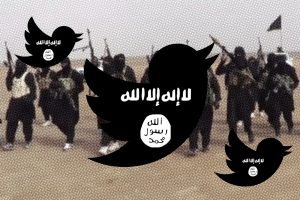 An image of ISIS fighters with the Twitter logo. Photo credits to ‘Fordham Political Review.’[1]
An image of ISIS fighters with the Twitter logo. Photo credits to ‘Fordham Political Review.’[1]
Introduction
In order to understand the relationship between social media and terrorism, we first need to understand the term ‘terrorism.’ Terrorism is the use of violence or intimidation as a means to create fear in order to achieve political aims. With the emergence of social media technology in recent years, terrorists are now capable of spreading fear to a global online audience, forcing people into submission. ISIS has been able to successfully use a range of social media platforms as a tool to enhance their movement by recruiting new members and spreading their message internationally.
The terrorist organization discussed in the article is known officially as the Islamic State of Iraq and Syria, but is also referred to as ISIS, ISIL (Islamic State of Iraq and the Levant), and the Daesh.[2] Their terror movement is primarily centered in the Middle East, particularly in Northern Iraq and in parts of Syria. However, the group has successfully been able to leverage social media, recruiting members from many western countries such as the United States, the United Kingdom, and Germany. Their terror movement has now expanded throughout the Western world. We will explore their history, offline presence, usage of propaganda, social media, and the dark web. We aim to provide context for this movement and explore how they have been able to effectively disseminate their information.
Unlike many terrorist groups that came before them, ISIS has employed the use of many forms of online media platforms including websites, social media campaigns, online magazines, and flyers as a method of recruiting new followers across international boundaries. They are particularly focused on the transmission of radical imagery and fundamentalist Islamic ideology. By utilizing these new technologies in innovative ways, the group has effectively been able to garner a strong international following. They have recruited followers from western countries, including but not limited to the United States, the United Kingdom, and Canada.[3] Further, their reach has spread internationally to members who do not feel included in Western society. This has led to the group’s connection to deadly shootings in the Western world, such as the coordinated November 2015 Paris attacks and the Pulse Nightclub Shooting.[4] Without social media, ISIS would still have been able to proceed with the majority of its agenda. However, it would not be very effective at recruiting internationally and encouraging lone actors in foreign countries.
Context
Social Issues/Events Being Addressed
There are many perspectives of the social issues or events that ISIS is involved in. The three viewpoints that we have chosen to focus on are: the citizens who live under ISIS’ reign, the ISIS fighters, and the Western perspective.
The Citizens who Live under ISIS:
The overall consensus of those living under ISIS reign is one of fear. We will explore four different accounts of citizens, who live in different regions in the Middle East that are under the control of ISIS.
First, we will look into the lives of those living in Mosul, Iraq. When Maclean’s, a Canadian journalism team, interviewed people living in the villages and camps around Mosul frontlines, they found that “each one of the people interviewed admitted that Islamic State’s arrival…was welcomed at first.” After dealing with an oppressive, sectarian Iraqi government, they were hoping for liberation and freedom. However, after witnessing ISIS’ use of civilians as human shields, threats to whip women’s hands for being disobedient of dress codes, and assassinations for owning objects like mobile phones, many are traumatized.[5]
In the ISIS-controlled city of Raqqa, in northern Syria, a broadcasted series titled “The Raqqa Diaries” recorded the experience of Samer (a disguised name) before being encrypted and translated into a book.[6] In Samer’s book, The Raqqa Diaries: Escape from Islamic State, he depicts the beheadings and their accusations: fighting with regime forces and speaking to foreign media.[7] The helplessness of the community is expressed, as they are forced to witness these horrific and unsubstantiated killings.[8]
Women have spoken out against the ISIS rule, risking their lives to contact Western journalists. Under the pseudonyms Om Omran and Om Mohammad, they wore hidden cameras to expose the life of an ISIS-run state.[9] In their interviews, they reiterate the importance of having freedom, without being scared for their safety. The two images below are lines from their videos.


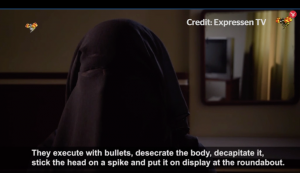
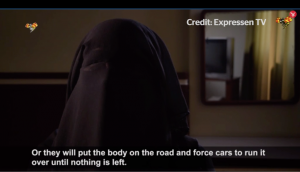 Excerpts from a TV interview with Woman living under ISIS. Documentary credits to ‘The Independent.’
Excerpts from a TV interview with Woman living under ISIS. Documentary credits to ‘The Independent.’
The ISIS Fighters (Fans):
The grouped the ISIS fighters can be categorized into nine physiological categories, based on the reasons or motives they gave for joining the organization and other extremist groups. The sheer number of categories demonstrates the complexity of motives for why fighters may be motivated to join ISIS. The categories are named based on the activity or feeling that they seek: status, identity, revenge, redemption, responsibility, thrill, ideology, justice, and death.[10]
The wide array of motives shows that people are joining ISIS for a variety of different reasons. Although many fighters join for the ideology proposed by the group. There are also many others who seek revenge, redemption, and justice. Many of these issues stem from the United States involvement in the Iraq War. The devastation and decades of war that have occured in Iraq and Syria have driven members into the hands of ISIS. There are also many non-traditional motives for ISIS fighters such as thrill, status, and identity. These motives were molded by propaganda.
 An image of typical ISIS fighters. Image credits to ‘The Independent.’[11]
An image of typical ISIS fighters. Image credits to ‘The Independent.’[11]
The Western Perspective:
Most Americans believe the government should intensify its assault on ISIS, but most remain opposed to sending troops to Syria or Iraq. A poll conducted in 2017 found that 60 percent of Americans think the United States should be doing more to attack Islamic State. A small majority said they support using airstrikes in Iraq and Syria, but about 65 percent oppose sending special forces to the region, a move that has already been taken by President Obama. When asked about regular ground troops, the opposition grew stronger with 76 percent opposed to deploying troops. The poll also found that 52 percent of Americans think nations which accept refugees fleeing the strife in Syria are less safe.[12]
Key Images
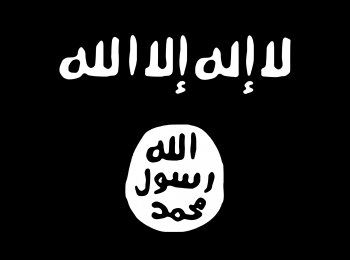 The flag often used by ISIS Fighters. Image credits to ‘The Independent.’[13]
The flag often used by ISIS Fighters. Image credits to ‘The Independent.’[13]
There are numerous key images associated with ISIS. The first key image is the recognizable black flag that is commonly shown in ISIS military parades. ISIS has used the flag similar to the way modern countries utilize their flags in a time of war.[14] This black flag with white symbols and writing has served as a key piece of propaganda. The white lettering on the top of the flag says, “There is no god but Allah [God]. Mohammad is the messenger of Allah.”[15] The White Circle located beneath is representative of a stamp used to seal an envelope and is often referred to as the seal of Mohammed. This flag is “monochrome” and draws from the ancient Middle Eastern tradition where similar flags were used. It is important to note that the flag is not unique to ISIS and is used by other terror organizations, such as Al-Shabab and Al-Qaeda. ISIS has been able to successfully claim this flag as their own and the many now associate the flag with only their organization.
History
ISIS was founded in 2004 by Abu Musab al-Zarqawi under the name ‘Al Qaeda of Iraq.’ This branch of Al Qaeda aimed to institute Sharia Law in its territories in Northern Iraq. Ultimately, ISIS’ goal is to form an Islamic Caliphate which will take over the world. This Caliphate will act as a nation and carry out Fundamental Islamic Law. However, the group had difficulty gaining traction in Iraq. In 2006, the founder, Abu Musab Al-Zarqawi was killed in an airstrike.[16] Given the U.S. troop surge in 2007, it proved impossible for the group to gain territory.
In 2013 the group merged with another group called Jabhat al-Nusra. After this merger, the group was given its current name, The Islamic State in Iraq and the Levant (ISIL).[17] Subsequently, ISIS had a string of military victories. The group captured many large cities in Northern Iraq in 2014 such as Fallujah, Mosul, and Tikrit. Later in June 2014, the group announced its mission to impose Sharia Law over the world’s 1.5 billion Muslims. In response, the U.S. government sent 300 “military advisors” to Iraq to evaluate the situation.[18] In addition, President Obama and the Pentagon authorized targeted airstrikes to prevent ISIS from killing in Northern Iraq. The United States continues to conduct drone strikes on key ISIS targets throughout Northern Iraq, Syria, and Libya.[19]
In January and November 2015, the group gained mass publicity from the Paris massacre shooting in which 128 people were injured and 12 people were killed. The shooters pledged their allegiance to ISIS minutes before the attack. ISIS specifically targeted the satirical newspaper Charlie Hebdo because the newspaper had recently published a political cartoon that poked fun at Allah.[20]
Timeline
October 2004
ISIS founded as Al Queda in Iraq. The group is founded by Abu Musab al Zawari, and is a key actor in toppling Saddam Hussein’s regime.
January 2007
United States Troops Surge in Iraq. ISIS’ ability to expand is limited by U.S. presence in Iraq
June 2011
ISIS re-emerged and took advantage of weakness in Syria and Iraq. Iraq and Syria are still in the midst of a war. They take advantage of anti-western sentiment and poverty in the region.
2013
Al Queda changed name to ISIS. This marks the beginning of their social media branding
June 2014
Assault on Key Iraqi Cities: Tikrit and Mosul. These are the first major victories for the organization.
June 29, 2014
Leader Abu Bakr al Baghdadi declares Caliphate, stretching from Iraq to Aleppo Syria. First instance of the group’s claim of world domination.
August 2014
U.S. Drone Strikes. International intervention in the region and effort to stop the organization.
November 2015
Paris Club Shooting. ISIS follower collaborated with headquarters to organize attack, killing 130 people. International Media attention to ISIS.
Google Trends
 Using the search term “ISIS,” we were able to determine that the group started gaining international web traffic starting in June 2014. On November 13, 2015, immediately after the Paris Club shooting, the group received a sudden spike in international attention on the Internet.[21]
Using the search term “ISIS,” we were able to determine that the group started gaining international web traffic starting in June 2014. On November 13, 2015, immediately after the Paris Club shooting, the group received a sudden spike in international attention on the Internet.[21]

The majority of the top 20 results for the search term “ISIS” and similar searches were located in the Middle East or in other Muslim countries. It is impossible to determine whether or not this is due to interest in the organization or concerns about the threat of the organization of the people living in the region. [22]
[22]
Key Actors
The following key actors are ISIS leaders, spokesmen, and recruiters. Many of these figures have been killed in action, or killed as targets of Western drone strikes. Some key actors include:
- Abu Bakr al-Baghdadi – Current Leader of ISIS
- Abu Muhammad al-Shimali – Key leader in ISIS’ Immigration and Logistics Committee and responsible for facilitating the travel of foreign fighters primarily through the border Turkey/Syria
- Abi al-Hassan al-Muhajer – Spokesman of ISIS, appointed in December 2016
- Gulmurod Khalimov – Former Tajik OMON Lieutenant-Colonel, currently a recruiter
- Sally Jones – British recruiter, also known as Umm Hussain al-Britani
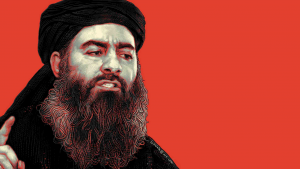
 Cover of ‘TIME Magazine’, published in 2015.[23]
Cover of ‘TIME Magazine’, published in 2015.[23]
 Sally Jones, also known as the Jihadi Bride. Image credits to ‘The Sun.’ [24]
Sally Jones, also known as the Jihadi Bride. Image credits to ‘The Sun.’ [24]
Demographics of Recruits
The main demographics of ISIS are Iraqi and Syrian. Computer Scientist Zeeshan Usmani posits that there are 71,000 people in North America, Australia, and Europe who are radical enough to have piqued interests in ISIS recruitment initiatives.
Usmani, GWU, and Brookings have collectively found common characteristics of ISIS recruits from Europe and in the West.[25]
The standard ISIS recruit from Western countries is relatively young. They are typically in their 20’s and GWU found the average age to be around 26 years old. Furthermore, 86% of these recruits are male which is reflective of the video’s target audience. The propaganda videos often show groups of men to promote a brotherly culture. Intriguingly, Usmani estimates that 73% of recruits and radicals are middle class or wealthier. They are often second or third generation immigrants. Usmani also found that the majority of the Western recruits don’t feel “at home” in their home country. GWU found that about half of the recruits attempt to travel abroad if they live in West. Many of these attributes defy the stereotypical characteristics of terrorists under the Western perspective.
In an in depth analysis of their social media, Usmani, GWU, and Brookings have found similar patterns in their behavior of ISIS recruits on social media platforms. Typically, these Western recruits do not like taking selfies. In Europe, over half of Facebook users post selfies. In contrast, Usmani discovered that only 1% of potential recruits take selfies. This suggests that some of these recruits may be highly self-conscious and are looking for ways to boost their self-esteem. These ISIS recruits also are much more likely to own and use Android devices over Apple devices, as nearly 70% of recruits have Android devices, according to Brookings. They are also more active on Twitter than the average Twitter user. Brookings found 62% of ISIS supporters had tweeted within the past month versus just 13% of all Twitter users.
Allies
ISIS has a variety of allies throughout the world. Although they are an offshoot of Al Qaeda, they have notoriously disowned by Al Qaeda due to their unprecedented level of violence and brutality.[26] However, their extreme tactics have gained notoriety among the Islamic Fundamentalist community and other international organizations. and has gained them support from many groups internationally. The Terrorism Research & Analysis Consortium has discovered that ISIS has supporters in at least 11 countries.[27] While the majority of these countries are Middle Eastern countries, other countries include Indonesia and the Philippines. Many of these groups are extremely small and have only about 1,000 fighters. Additionally, many of these groups are non-violent, but preach extremist Islamic ideals. Some of these groups include, Ansar Beit al-Maqdis, Tehreek-e-Khilafat, and Jamaat al-Ahrar. These same groups have also pledged allegiance to Taliban and Al Qaeda.
Social Media Presence
A large part of the ISIS recruitment occurs on traditional social media platforms such as Facebook, Twitter, YouTube, and Telegram. Many of these corporate platforms have chosen to censor the materials disseminated by ISIS due to their violent nature.[28] ISIS has thus migrated their recruitment efforts to the dark web. We will also examine the mediums, messages, and intentions behind each form of propaganda.
Usage of Mainstream Social Media
Between 2013 and 2014, the organization primarily used mainstream social platforms, like Twitter, Facebook, and Telegram. During 2014, there was an estimated 46,000 to 90,000 Twitter accounts that advocated for ISIS or were run by supporters of the movement.[29] In 2015, Twitter was able to ban 125,000 ISIS sympathetic accounts.[30] ISIS utilized a technique called “Jihadist Follow Friday” to encourage their users to follow new ISIS sympathetic accounts each Friday.18 To signify this, they used many hashtags in Arabic, like #theFridayofSupportingISIS. This allowed them to gain followers each week and to promote their community and message on a weekly basis.[31]
After these accounts were banned, ISIS supporters then created new accounts to replace the previous ones. Twitter defines those who recreate accounts as “resurgents” and explains that these are often difficult accounts to remove completely, since they tend to pop back up in an alternate form. It is estimated that approximately 20% of all ISIS affiliated Twitter accounts can be traced back to fake accounts created by the same user.20 Many of these accounts are traced back to the “Baqiya family,” which is an online network of thousands of ISIS followers. During important ISIS military victories, there is a sudden surge of tweets. During the ISIS march on Mosul on March 24, 2016, there was about 42,000 tweets on Twitter supporting the invasion.
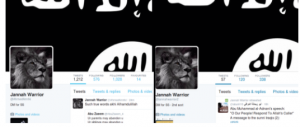 An example of two identical Pro-ISIS Twitter Accounts. Credits to ‘The Journal of Terrorism Research.’[32]
An example of two identical Pro-ISIS Twitter Accounts. Credits to ‘The Journal of Terrorism Research.’[32]
Telegram is an encrypted messaging and end-to-end user encryption platform that has become the “app of choice” for ISIS.[33] It also has special features, such as a self-destruct timer that erases all evidence and messages. The application has a user data protection policy because violating this policy could potentially damage the app’s brand of customer privacy. However, in July 2017, the application came under immense scrutiny. It was documented that ISIS gunmen used this app to maintain contact with ISIS leaders in Raqqa days before terror attacks in Turkey, Berlin, and St. Petersburg. Despite this, there had been little to no action taken against ISIS accounts until July 2017 when Telegram finally decided to ban ISIS-related accounts.[34]
On Telegram, ISIS often uses the hashtag #KhilafahNews to attract their users. To this day, ISIS channels on Telegram remain relatively active despite efforts to ban them. ISIS started using Telegram as an anchor platform to connect with their user base and to enact their social media campaigns when their other accounts were banned on Twitter and Facebook.[35] On Telegram, there are also secret channels that are undetectable and only found by using special keys set by the channel leaders. Government agencies are unable to break Telegram’s encryption technology and therefore cannot shut down ISIS’ channels. In 2017, Telegram banned dozens of pro-ISIS channels.

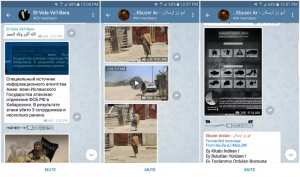 Screenshots of ISIS channels on Telegram, courtesy of Ahmet S. Yayla. Credits to ‘Vox Media.’[36]
Screenshots of ISIS channels on Telegram, courtesy of Ahmet S. Yayla. Credits to ‘Vox Media.’[36]
Justpaste.it, an anonymous photo and text sharing website, has also been heavily utilized. With the option to lock images, the website allows anonymous users to send and receive content without a formal registration process. For this reason, ISIS members have shared photos of countless murders, executions, and battlegrounds onto the app to be disseminated to other applications.[37]
In order to stop ISIS from using the website, there is only one option: shutting it down. However, founder Mariusz Żurawek has previously stated his opinion against doing so. He said, “I do not want to interfere with any type of conflict and stay on one side. Justpaste.it has many users. I cannot focus on a single group. I don’t see any reason why they should shut down the service. Should they shut down Twitter, too?”[38]
In 2014, Justpaste.it removed graphic content from the website, promoting ISIS to launch their own content-sharing platforms. These new options include Manbar.me, in 2014, Nasher.me in January 2015, and Alors.ninja, in July 2015.[39] ISIS’ social media campaigns rely most heavily on Manbar.me to distribute propagandist photos of battles and city raids. In 2016, ISIS introduced PasteMaker and Sharetext, which mirrored the encrypted messages in Justpaste.it. These new platforms were considerably more difficult to navigate, so ISIS returned to using Justpaste.it.[40]
The November 2015 ISIS attacks in Paris were perpetrated without prior warning, largely because the operatives met face-to-face and used other non-digital means of communication. Additionally, ISIS claims responsibility for many terror attacks around the world such as the Paris Attacks, the Florida night club shooting, and the Las Vegas attack.[41]
Usage of the Dark Web
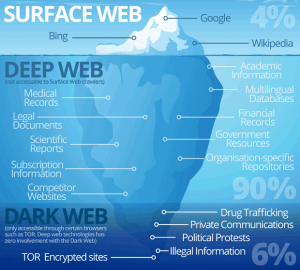 Infographic showing the division of the web. Image Credits to ‘Cisco Blogs.’[42]
Infographic showing the division of the web. Image Credits to ‘Cisco Blogs.’[42]
Since ISIS’ activities on the surface web are now being monitored closely by different international governments, jihadists are now forced to look for new online safe havens. The dark web is the perfect alternative; it is inaccessible to most but navigable for the initiated few, and it is completely anonymous.[43] ISIS has published a variety of content on the dark web as well as on their own internally generated platforms.
In response to corporate social media platforms banning their accounts, ISIS has made their own social media platform to increase their ability to spread their messages. Without the intervention of corporate actors such as Twitter, ISIS would have been able to freely spread their messages on the surface web. In 2017, Europol, the European Police, uncovered 52 unique online ISIS networks containing over 2,000 unique extremist items.[44]
Given certain features of the dark web, like the fact that a special browser is required for access and that it is untraceable, terrorism specialists face many difficulties in tracking down ISIS’ dark web activities.
Internal Social Media Policy
Ironically, ISIS has procedures in place that ban their supporters from using social media after they have been radicalized. Citing mantras such as “command something that the soul dislikes, obeying them is obligatory,” ISIS has been able to control their follower’s Internet access. This internal social media ban is a result of the growing bureaucracy and divide within ISIS. Members are becoming increasingly dissatisfied with the organization’s leadership. This social media ban is an attempt by the current leadership to suppress internal dissent.[45]
Propaganda
Due to the fact that many of the ISIS accounts have been removed from traditional social media platforms, such as Twitter, Facebook, and YouTube, we have chosen to focus on the propaganda materials that they often distribute, including their magazine, videos, and application. ISIS distributes their material in 25 languages in order to reach the maximum number of international viewers and potential new recruits.
Magazine: Rumiyah
One of the most prominent forms of media unique to ISIS’ recruitment campaign is their online magazine, called Rumiyah. The magazine is a professional publication with advanced graphic designs, official interviews with ISIS’ leadership, and infographics. The magazine is focused on discussing both jihadist ideals and the war that ISIS is currently fighting.[46]
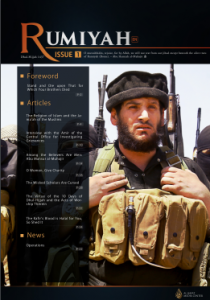
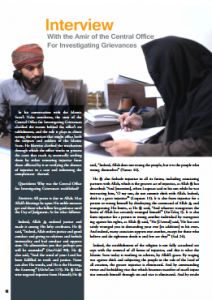 The Pages from the First Issue of Rumiyah. Image credits to ‘The Clarion Project.’[47]
The Pages from the First Issue of Rumiyah. Image credits to ‘The Clarion Project.’[47]
There are numerous instances of extremist ideology embedded throughout the magazine. For example, there is a picture of a British man standing at a farmers market in the magazine’s first issue. The author of the article states that he and other young adults are acceptable targets for a terrorist attack.[48]
Recruitment Videos
In an evaluation of ISIS’ online recruitment campaign, the Institute for the Study of War cites three main goals by ISIS:
- Convey Narrative of Global War and Ultimate Victory[49]
- Radicalize Populations Globally[50]
- Encourage international lone state actor and small cell attacks in support of ISIS
These intentions are particularly clear in ISIS’ propaganda videos, which are typically created to target young impressionable Sunni Muslim boys.[51] These videos are often of high production quality and incorporate montages, slow motion scenes, and are accompanied by a short dialogue. ISIS has a dedicated team of over 100 media insurgents whose sole responsibility is to record these videos. Many of these videographers previously held positions at large technology companies and are treated as “emirs” or senior officials in ISIS. Reportedly, the camera men are given a month of special camera training in addition to military basic training.[52]
ISIS’ videos often include the executions of “enemies of the Caliphate,” westerners, or Jordanian nationals. Most infamously, an executioner named Jihadi John was featured in many of these videos prior to his death in 2015.[53] John was notorious for murdering many U.S., UK, and Japanese citizens, such as Steven Sotloff, David Haines, and Alan Henning on video.[54]
In addition to their violent videos, ISIS has also created and published a variety of videos displaying their philanthropy and brotherhood. In the image shown below, ISIS soldiers can be seen giving out candy to children. ISIS propaganda also largely promotes the element of brotherhood. This allows them to reach fringe groups scattered throughout the world. As mentioned before, ISIS has been able to recruit many lone actors from Western countries who feel a sense of community and belonging through ISIS propaganda.[55]
 Screenshot of an ISIS Propaganda Video showing fighter giving candy to children. Image credits to ‘Vice News.’ [56]
Screenshot of an ISIS Propaganda Video showing fighter giving candy to children. Image credits to ‘Vice News.’ [56]
Smartphone Application: The Dawn of Glad Tidings
ISIS created The Dawn of Glad Tidings, an Arabic Language application. It shares many of the tweets from ISIS sympathetic accounts. Additionally, it allows users to see and monitor hashtags, tweets, images, videos, and comments that were posted on their accounts. This application was downloaded several hundred times on the Google Play app store before being forcefully taken down.[57]
Impact of Social Media Censorship
Many of the ISIS sympathetic social media accounts were recognized by the United States government. The government reached out to many large social media platforms, including Twitter and YouTube, to remove these accounts and videos, saying that these materials violated the company’s terms of service.[58] Although there were some lawsuits citing the First Amendment and the protection of freedom of speech, the government was able to take down the accounts and posts that violated Section 2339B. This requires that the material must be removed or banned if tied to any “knowledge about the organization’s connection to terrorism.”
In a 2016 study of pro-ISIS accounts on Twitter, researchers discovered the following:

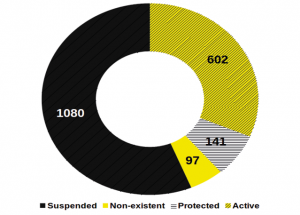 Graph depicting Pro-ISIS Twitter Accounts. Chart credits to ‘The Journal of Terrorism Research.’[59]
Graph depicting Pro-ISIS Twitter Accounts. Chart credits to ‘The Journal of Terrorism Research.’[59]
Analog Antecedents
Some antecedents include the division of ISIS supporters and protesters. Many tweets associated with ISIS have since been deleted for violating Twitter’s terms and agreements, there is a clear distinction between those who support ISIS’ propaganda and those who are openly oppose the terror movement. An analog antecedent is an event that occured prior to ISIS that helped contribute to its strength. One of these connections can be made to the Arab Spring uprisings that resulted in a failure to create major regime changes throughout the Middle East. We also find “temporal patterns in the support and opposition which seems to be linked to major news, such as reported territorial gains, reports on gruesome acts of violence, and reports on airstrikes and foreign intervention.”[60]
 Iraqi Sunnis and Shias Pro-ISIS demonstrators in Mosul, 2014. Photo courtesy of ‘Associated Press.’[61]
Iraqi Sunnis and Shias Pro-ISIS demonstrators in Mosul, 2014. Photo courtesy of ‘Associated Press.’[61]
Mosul is a city in northern Iraq that serves as a booming industrial location for oil trade between Turkey and Syria.[62] On June 6, 2014, ISIS jihadists forced the Iraqi military and a large population out of Mosul, seizing the city and allowing them to loot gold and cash worth $500 million from the Central Bank of Mosul.[63] Many civilians hoped for better conditions of living, as seen in the photo of a rally above. However, pre-existing conflicts between the Sunnis and Shias, the two largest Arab religious groups in Iraq, has helped ISIS with recruitment. The majority of ISIS fighter are Sunni. However, throughout the Middle East, the Shia Muslims are the majority and Sunni Muslims are often discriminated against. ISIS have been utilizing this power struggle as a propaganda message for interested fighters.[64]
Arab Spring as an Antecedent
Many argue that there is an inherent connection between the Arab Spring uprisings and ISIS’ growth. “Arab Spring” is the popular name given to the democratic wave of civil unrest in the Arab world that began in December 2010 and lasted through mid-2012. The failures of some of the uprisings demonstrated that social media was a way to facilitate civil unrest. As a result, ISIS had the ideal environment to perpetuate their messages of terror. Different uprisings in Egypt, Tunisia, and Libya, account for the various methods in which ISIS officials took advantage of the chaos to advocate for their messages of extremism.[65]
Impact of the Movement
Social media platforms such as Facebook and Twitter were designed to connect and communicate with people around the world; however, when they are used by terrorists, they are morphed into weapons of killing. These platforms allowed ISIS to rapidly spread their ideology and influences across the world, posing as threats to the national security of many Western nations. In addition to social media technologies, ISIS’ power and influence in the dark web has provided them with outlets to trade weapons and recruit members without virtual regulations. Given the fact that contents posted on the dark web are untrackable, anti-terrorism activities online became even more difficult to procure. Such success for this terrorism movement has made way for other extremist groups to take their agendas to the web.[66]
ISIS is following a well-planned strategy and the group is selective with what they post. They choose photos that have the potential of having a strong impact, presumably to create fear among its enemies and win the admiration of other radical groups.
Unlike other jihadist groups, such as the al-Qaeda affiliate in Syria the Nusra Front, ISIS gives little consideration to the way it is perceived by the general public.
The Nusra Front, on the other hand, regularly posts statements and videos, showing the group’s social services, including the distribution of food to the poor and traffic management. The Nusra Front’s approach has helped the group gain support at the grassroots level in Syria.[67]
Critiques of the Movement
Both national governments and corporations have taken a stand against ISIS in the physical and virtual spheres. The U.S. Department of State announced an international coalition in 2014, in which they list five lines of effort to expose ISIS.[68] They include:
- Providing military support to partners
- Impeding the flow of foreign fighters
- Stopping financing and funding
- Addressing humanitarian crises in the region
- Exposing true nature
Companies are also taking action to hinder ISIS’ social media recruitment attempts. Google’s ThinkTank, Jigsaw, launched a collaboration with YouTube in July, 2017 to redirect any potential recruits using the Redirect Method.[69] “The Redirect Method uses Adwords targeting tools and curated YouTube videos uploaded by people all around the world to confront online radicalization. It focuses on the slice of ISIS’ audience that is most susceptible to its messaging, and redirects them towards curated YouTube videos debunking ISIS recruiting themes. This open methodology was developed from interviews with ISIS defectors, respects users’ privacy and can be deployed to tackle other types of violent recruiting discourses online.”[70]
By using this tactic, Jigsaw catches slogans that manifest any positive ISIS sentiments, like “Baqiyah wa Tatamadad” (Remaining and Expanding), and “Al Dawla Al Islameyah,” which includes “al-Dawla,” a sign of respect. These slogans are a part of ISIS’ social media campaign and many of these slogans are used to cultivate an online community.
Lastly, Anonymous declared war against ISIS in November of 2015, attempting to thwart the social media recruitment efforts by targeting ISIS’s communication networks.[71]
Conclusion
We conclude that ISIS would not have become as influential as it is today without social media. ISIS actively and advantageously utilized social media to bring awareness to their cause, recruit members into their regime, and ultimately spread propaganda online. Their content can typically be defined as extremist and pushes the many boundaries developed by various social media platforms. Despite this, a great deal of their content depicts the Islamic Caliphate as a wholesome society. They work to perpetuate the war on terror through the existence of these accounts and have cultivated a department dedicated to the fostering of their social media presence. From professional videos to engaging graphics, ISIS shares content that is relatable to a younger audience which makes recruiting all the more successful at home and abroad.Though ISIS has been strategic with the spreading of propaganda prior to the eruption of online platforms, the integrated use of social media has facilitated the completion of their goals by large measures.
Social media, just like many technological advancements, is only a tool– a double edged sword. Social media can be utilized as an accelerator of social movements and lead to positive social changes if it is used wisely. However, upon falling into the wrong hands, it could be used as a dangerous weapon against civil society and eventually lead to catastrophic results. Individuals should be cognizant of the consequences of their actions when using technology like social media as a tool to spread messages about a specific cause. Ultimately, it is important to remember that social media itself does not create social movements–people are the key actors behind social movements.
Authors
Sara Park: Sara is a senior at UC Berkeley studying Political Economy, with a concentration in International Trade and Technology. She is also pursuing a certificate of Technology Entrepreneurship from the UC Berkeley College of Engineering. She is passionate about teaching financial literacy, and runs yearly finance seminars as CEO of Smart Woman Securities at Berkeley.
Sona Senapati: Sona is a junior at UC Berkeley, majoring in Economics. Aside from academics, she is involved in blogging for Berkeley-Haas’ Center for Responsible Business and does pro bono consulting through Consult Your Community.
Kevin Phan: Kevin is a senior at UC Berkeley-Haas studying Business Administration, with an interest in Finance. Outside of school, he is involved in multiple on-campus organizations.
Breeze Wen Liu: Breeze is a senior at UC Berkeley majoring in Peace and Conflict studies, with a concentration on National Politics, International Relations and World Order. She is an activist in women empowerment and hoping to find new solutions in peacebuilding through entrepreneurship.
[1] Merchant, Yasmin. “How ISIS Recruits Through Social Media.” FORDHAM POLITICAL REVIEW, 19 Sept. 2015, fordhampoliticalreview.org/how-isis-recruits-through-social-media/.
[2]Irshaid, Faisal. “Isis, Isil, IS or Daesh? One group, many names.” BBC News, 2 December 2015, http://www.bbc.com/news/world-middle-east-27994277. Retrieved 10 October 2017.
[3] Ingraham, Nathan. “ISIS Created Its Own Social Network to Spread Propaganda.” Engadget, 4 May 2017.
[4]O’Brien, Cortney. “CIA Director GIves Grim Assessment of Fight Against ISIS.” Townhall, 16 June 2016, https://townhall.com/tipsheet/cortneyobrien/2016/06/16/cnn-cias-terror-report-didnt-inspire-much-hope-n2179302. Retrieved 10 November 2017.
[5] “Life under ISIS: Four stories of terror endured – Macleans.ca”. Macleans.ca. 2016-12-14. Retrieved 1, December 2017.
[6]“What It’s Like to Live in ISIS-Controlled Raqqa”. Vice. 2017-03-07. Retrieved 2017-12-01.
[7]“The Raqqa Diaries: life under Isis rule”. The Observer. 2017-02-26. ISSN 0029-7712. Retrieved 2017-12-01.
[8] Thomson, Mike (2016-03-05). “Inside ‘Islamic State’: A Raqqa diary”. BBC News. Retrieved 2017-12-01.
[9]“Two women release secret footage of what life is really like living under Isis”. The Independent. 2016-03-13. Retrieved 1, December 2017.
[10] Tucker, Patrick. “Why Join ISIS? How Fighters Respond When You Ask Them”. The Atlantic. Retrieved 28, November 2017.
[11] Fenton, SIobhan. “ISIS not supported by overwhelming majority of young Arabs, research suggests.” The Independent, 12 April 2016, http://www.independent.co.uk/news/world/middle-east/overwhelming-majority-of-young-arabs-do-not-support-islamic-state-and-think-it-will-fail-research-a6980881.htmlI. Retrieved 2 December 2017.
[12]“How Americans feel about ISIS and Syria after the Paris attacks”. Business Insider. Retrieved 1, December 2017.
[13] “Isis flag: What do the words mean and what are its origins?”. The Independent. 7 July 2015.
[14]“What the words on Isis’ flag mean”. The Independent. 2015-07-06. Retrieved 1, December 2017.
[15] “What the ISIS Flag Says About the Militant Group”. Time. Retrieved 1, December 2017.
[16] “ISIS – Facts & Summary – HISTORY.com”. HISTORY.com. Retrieved 2017-12-01.
[17]Library, CNN. “ISIS Fast Facts”. CNN. Retrieved 1, December 2017.
[18] Library, CNN. “ISIS Fast Facts”. CNN. Retrieved 1, December 2017.
[19]Horton, Alex (2017-09-24). “U.S. drone strikes kill 17 Islamic State fighters in Libya, military says”. Washington Post. ISSN 0190-8286. Retrieved 1, December 2017.
[20] CNN, Steve Almasy, Pierre Meilhan and Jim Bittermann,. “Paris massacre: At least 128 die in attacks – CNN”. CNN. Retrieved 1, December 2017.
[21] <script type=”text/javascript” src=”https://ssl.gstatic.com/trends_nrtr/1225_RC05/embed_loader.js”></script> <script type=”text/javascript”> trends.embed.renderExploreWidget(“TIMESERIES”, {“comparisonItem”:[{“keyword”:”isis”,”geo”:””,”time”:”today 5-y”}],”category”:0,”property”:””}, {“exploreQuery”:”date=today 5-y&q=isis”,”guestPath”:”https://trends.google.com:443/trends/embed/”}); </script>
[22] <script type=”text/javascript” src=”https://ssl.gstatic.com/trends_nrtr/1225_RC05/embed_loader.js”></script> <script type=”text/javascript”> trends.embed.renderExploreWidget(“GEO_MAP”, {“comparisonItem”:[{“keyword”:”isis”,”geo”:””,”time”:”today 5-y”}],”category”:0,”property”:””}, {“exploreQuery”:”date=today 5-y&q=isis”,”guestPath”:”https://trends.google.com:443/trends/embed/”}); </script>
[23] Calabresi, Massimo. “TIME Person of the Year 2015 Runner-Up: Abu Bakr al-Baghdadi”. TIME.com. Retrieved 1, December 2017.
[24]“The lowdown on Sally Jones, the notorious ‘White Widow’ Isis figher”. The Sun. 2017-11-09. Retrieved 1, December 2017.
[25]Long, Heather. “Big Data reveals the surprising profile of an ISIS recruit”. CNNMoney. Retrieved 1, December 2017.
[26] Phillips, James. “ISIS vs. Al Qaeda: The good news and the bad news”. The Heritage Foundation. Retrieved 1, December 2017.
[27] “ISIS Now Has a Network of Military Affiliates in 11 Countries Around the World”. Daily Intelligencer. Retrieved 1, December 2017.
[28]Lawson, Mark (2017-05-17). “Isis: The Origins of Violence – a brave documentary that will start many a fight”. The Guardian. ISSN 0261-3077. Retrieved 1, December 2017.
[29]Wright, Shaun; Denney, David; Pinkerton, Alasdair; Jansen, Vincent A.A.; Bryden, John (2016-05-17). “Resurgent Insurgents: Quantitative Research Into Jihadists Who Get Suspended but Return on Twitter”. Journal of Terrorism Research. 7 (2). doi:10.15664/jtr.1213. ISSN 2049-7040.
[30] Koerner, Brendan I. “Why ISIS Is Winning the Social Media War—And How to Fight Back”. WIRED. Retrieved 1, December 2017.
[31]Morgan, J.M. Berger and Jonathon (-001-11-30T00:00:00+00:00). “The ISIS Twitter census: Defining and describing the population of ISIS supporters on Twitter”. Brookings. Retrieved 1, December 2017.
[32] Wright, Shaun; Denney, David; Pinkerton, Alasdair; Jansen, Vincent A.A.; Bryden, John “Resurgent Insurgents: Quantitative Research Into Jihadists Who Get Suspended but Return on Twitter”. Journal of Terrorism Research. 17, May 2016. 7 (2). ISSN 2049-7040. doi:10.15664/jtr.1213.
[33] Tan, Rebecca. “Terrorists’ Love for Telegram, Explained.” Vox, Vox Media, 30, June 2017. Retrieved 3, October 2017.
[34] Ibid.
[35] Binder, Laurence.”Wilayat Internet: ISIS’ Resilience across the Internet and Social Media.” 1, September 2017, https://www.bellingcat.com/news/mena/2017/09/01/wilayat-internet-isis-resilience-across-internet-social-media/. Retrieved 10, October 2017.
[36] Tan, Rebecca. “Terrorists’ Love for Telegram, Explained.” Vox, Vox Media, 30, June 2017. Retrieved 3, October 2017.
[37] Silverman, Jacob (August 28, 2014). “Loose Tweets Sink Ships–Will the Islamic State’s aggressive Internet strategy expose it to investigators?”. Politico. Retrieved November 2, 2017.
[38] Fishwick, Carmen (August 15, 2014). “How a Polish student’s website became an Isis propaganda tool”. The Guardian. Retrieved November 1, 2017.
[39] Stalinsky, Steven (June 6, 2016). “The Jihadi Cycle On Content-Sharing Web Services 2009-2016 And The Case Of Justpaste.it: Favored By ISIS, Al-Qaeda, And Other Jihadis For Posting Content And Sharing It On Twitter – Jihadis Move To Their Own Platforms (Manbar, Nashir, Alors.Ninja) But Then Return To Justpaste.it”. Inquiry & Analysis Series. No.1255.
[40] Stalinsky, Steven (June 6, 2016). “The Jihadi Cycle On Content-Sharing Web Services 2009-2016 And The Case Of Justpaste.it: Favored By ISIS, Al-Qaeda, And Other Jihadis For Posting Content And Sharing It On Twitter – Jihadis Move To Their Own Platforms (Manbar, Nashir, Alors.Ninja) But Then Return To Justpaste.it”. Inquiry & Analysis Series. No.1255.
[41]Morgan, J.M. Berger and Jonathon (-001-11-30T00:00:00+00:00). “The ISIS Twitter census: Defining and describing the population of ISIS supporters on Twitter”. Brookings. Retrieved 1, December 2017.
[42] Dodson, Kenn. “Trick-Or-Treat? As Cybersecurity Month winds down, which will your agency pick?” Cisco Blogs, Cisco, 25 October, 2017. Retrieved 2, December 2017.
[43] Bertrand, Natasha. “ISIS is taking full advantage of the internet.” http://www.businessinsider.com/isis-is-using-the-dark-web-2015-7. Business Insider. 11, July 2015. Retrieved 3, October 2017.
[44] Koerner, Brendan I. “Why ISIS Is Winning the Social Media War—And How to Fight Back”. WIRED. Retrieved 1, December, 2017.
[45]“Isis just banned all its fighters from using social media”. The Independent. 2017-06-22. Retrieved 1, December, 2017.
[46] “Rumiyah First Edition.” Rumiyah First Edition, 5 Sept. 2016, https://clarionproject.org/factsheets-files/Rumiyah-ISIS-Magazine-1st-issue.pdf.
[47]Image: “Rumiyah First Edition.” Rumiyah First Edition, 5 Sept. 2016, https://clarionproject.org/factsheets-files/Rumiyah-ISIS-Magazine-1st-issue.pdf.
[48] “The new Isis magazine is hiding a huge signal the group’s days may be numbered”. The Independent. 2016-09-06. Retrieved 2017-12-01.
[49]Understanding War. National War Institute. 2016-09-06. Retrieved 1, December 2017.
[50]Ibid.
[51] Awan, Imran (2017-04-01). “Cyber-Extremism: Isis and the Power of Social Media”. Society. 54 (2): 138–149. doi:10.1007/s12115-017-0114-0. ISSN 0147-2011.
[52]Miller, Greg; Mekhennet, Souad (2015-11-20). “Inside the surreal world of the Islamic State’s propaganda machine”. Washington Post. ISSN 0190-8286. Retrieved 1, December 2017.
[53]Rayner, Gordon (2015-11-13). “How the US and UK tracked down and killed Jihadi John”. ISSN 0307-1235. Retrieved 1, December 2017.
[54]Casciani, Dominic (2015-11-13). “Who is Mohammed Emwazi?”. BBC News. Retrieved 2017-12-01.
[55] “ISIS Has a Really Slick and Sophisticated Media Department | VICE News”. VICE News. Retrieved 1, December 2017.
[56]VICE News (2014-07-11), ISIS Releases Recruitment Video of Militants Giving Candy to Children, retrieved 2017-12-01
[57] “Isis official app available to download on Google Play”. ITV News. Retrieved 1, December 2017.
[58]Knox, Emily Goldberg, “The Slippery Slope of Material Support Prosecutions: Social Media Support to Terrorists.” Hastings Law Journal, Vol. 66, No. 1, 2014.
[59] Wright, Shaun; Denney, David; Pinkerton, Alasdair; Jansen, Vincent; Bryden, John (2016-05-17). “Resurgent Insurgents: Quantitative Research Into Jihadists Who Get Suspended but Return on Twitter”. Journal of Terrorism Research. 7 (2). doi:10.15664/jtr.1213/. ISSN 2049-7040.
[60] Magdy, Walid; Darwish, Kareem; Weber, Ingmar (2015-03-09). “#FailedRevolutions: Using Twitter to Study the Antecedents of ISIS Support”. arXiv:1503.02401 [physics].
[61] New York Times. 22FILKINS-master768.Jpg. Retrieved 3, October 2017.
[62]“Where is Mosul, when was the Iraqi city taken from Isis and how many people died in the battle?”. The Sun. 2017-11-07. Retrieved 2017-12-01.
[63]Tait, Robert. ISIS’ half-a-billion-dollar bank heist makes it world’s richest terror group. The Telegraph. 14, June 2014.http://www.telegraph.co.uk/news/worldnews/middleeast/iraq/10899995/ISIS-half-a-billion-dollar-bank-heist-makes-it-worlds-richest-terror-group.html. Retrieved 3, October 2017.
[64]Beauchamp, Zack. “18 Things about ISIS You Need to Know.” Vox. 17, November 2015. Retrieved 3, October 2017.
[65]Attkisson, Sharyl. “How Arab Spring Opened the Door to Terrorism’s Ugly March.” The Daily Signal. 12, March 2015. http://dailysignal.com/2015/03/12/arab-spring-opened-door-terrorisms-ugly-march/
[66]Magee, Tamlin. “How ISIS runs its central media operation.” TechWorld. 29, Sept. 2017. https://www.techworld.com/security/how-isis-runs-its-central-media-operation-3664672/. Retrieved 3, October 2017.
[67] “Profile: Syria’s al-Nusra Front”. BBC News. 2013-04-10. Retrieved 1, December 2017.
[68] “The Global Coalition To Defeat ISIS.” U.S. Department of State, U.S. Department of State, 10 Sept. 2014, www.state.gov/s/seci/.
[69] Snider, Mike. “YouTube Redirects ISIS Recruits to Anti-Terrorist Videos.” USA Today, Gannett Satellite Information Network, 20 July 2017.
[70] “The Redirect Method.” The Redirect Method, redirectmethod.org/.
[71] Cohen, Paula. “Anonymous Hackers’ Group Declares War on ISIS.” CBS News, CBS, 16 Nov. 2015, www.cbsnews.com/news/anonymous-hackers-declare-war-on-isis/. Retrieved 1 October 2017.
